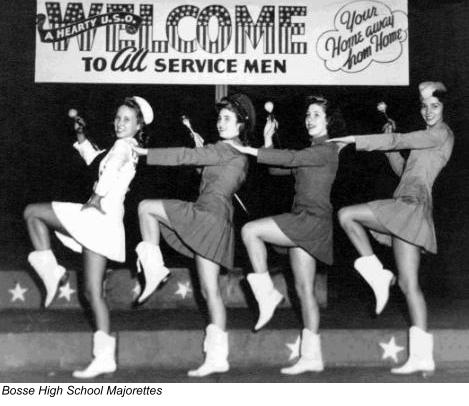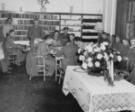One of the finest things a WWII soldier could do was to walk into a USO seeking a place of rest and comfort. The GI was always well accommodated, even treated as a hero.
Most towns with a RR station had a USO center and/or a canteen. Any city that was near a military camp, air field or navy yard would have a large USO. These were of a high class, attractive and inviting.
USO?for United Service Organization. Nearby USOs were located in Owensboro, Henderson,
Morganfield, Sturgis, Carmi, Lawrenceville, Vincennes, Princeton and Evansville.
Evansville, Henderson and Morganfield had two USO clubs, one for African Americans and one for white service men and women. Other area towns may have had a second USO as well.
The Evansville Red Cross Canteen served every serviceman and woman regardless of race while USOs were segregated. Segregation appears to have been the national practice and not a decision by the individual USO.
(Clarification: 'Canteens' served meals and provided simple aid to service men and women. Canteens were generally hosted by the American Red Cross. USOs provided sleeping and recreation services, snacks rather than meals were customary.)
Evansville had two excellent USO clubs that were appealing to the eye and conveniently located. The Main (Street) USO Club was on the corner of Eighth and Main Streets in downtown Evansville. The Main USO was operated by the Salvation Army.
Before the war this building was the C&EI RR Depot, after WWII it became the Community Center for high school kids. (The old architectural masterpiece was torn down to provide for the Civic Center which isolated Main Street. This may have been the death knell to the downtown area.)
The Lincoln (Avenue) USO Club was located at Lincoln and Morton Avenues. The large building was formerly the Guardian Orphan Home. After the war the historic building became the Carver Community Center. Later it was demolished; the site is now Bellmeade City Park.
Even before Pearl Harbor, Tri-state cities and civic groups began to consider the creation of USO type services. When Camp Breckinridge opened several Evansville churches and secular groups began to offer sleeping cots and meals at two or three dozen locations.
In May, 1942 the first USO club was established at 127 NW Third Street. This USO gave aid to traveling soldiers and trained volunteer workers. Directions to the location of meals and more than one thousand sleeping cots were provided.
The Salvation Army set up their Mobile Canteen at Fifth & Main Streets in November, 1942. One month later the former C&EI RR Depot became the Main Street USO. The city received a grant of $63,000 to renovate the former railroad depot; rent was $200 per month.
While details were not found, the Lincoln USO Club was also remodeled. The Lincoln USO was operated by the Evansville USO Council.
With good judgment, both Evansville USOs were dedicated on the same day, Sunday, November 14, 1943. This was just in time for the great Normandy invasion ?rush? when most military and war facilities and services were given greater priority. (In the month before the Normandy invasion Evansville LST production reached 12 ships, about 300 P-47s were built that month of May.)
The Lincoln USO could accommodate 100 persons in the club house with an additional 150 cots in the Lincoln High School building which was directly across Morton Avenue.
A temporary USO was established on Main Street in Morganfield in July, 1942 while permanent buildings were being made ready for the two USOs. The Henderson USO opened three weeks later on Second Street with the lower of its three floors ready for use.
The busiest day on record at the Main USO in Evansville had more than 5,000 visiting servicemen in late 1943. Camp Breckinridge and George Army Air Field were not yet at their peak census so it is likely that even greater crowds were seen in 1944.
Many citizens made volunteer service their way of life during the war. USO volunteers provided regular and diverse entertainment, traveler's aid, dances, hobbies, transportation, lodging and housekeeping service.
For these selfless USO volunteers, the main thing was support of the troops, no matter how hard it was; "The Troops Ruled" was the motto. A soldier's visiting family members were given lodging and USO services, often provided in private homes.
One USO service group was the Girls Service Organization (GSO) which was 700 strong by early 1943. GSO girls were unmarried, between 17 and 29 years old. Similar groups were the Civil Defense Cadettes and Business Girls, Inc.
The USOs provided community services during natural disasters and local emergencies. (Soldiers often volunteered their help as well.) The USOs doubled-up to take in as many refugees as possible.
The first annual report from the Main USO is lengthy; a condensed report will give some understanding of what USOs provided. The report begins "The building was transformed from a dirty railway station to one of the finest USO centers in the country."
In the previous 12 months 327,798 soldiers were in attendance, 80,225 attended dances hosted by 6,894 girls. The 278 beds were filled every Saturday night with about 80 additional men sleeping on chairs, tables and the floor. 300 Normally attended Sunday morning services. 15,000 men took advantage of the Sunday evening buffet suppers. (Can you imagine anything like this going on in 2007?)
Music, discussions, painting, photography and group singing was always a part of week-end programs. (The report tells that while most week-end guests would be army GIs and the mid-week visitors would be sailors.)
Forgive me for repeating this USO story that was first printed in the Maturity Journal 18 months ago. It was told by Shirley Ann Osias, nee Toon. Shirley worked in the Johnny Brinker Market on North Heidelbach Avenue at age 11 where she was the cash register operator. (Shirley is now 74.) It was best that the age question was not asked as Shirley's volunteer work at such a young age was something everybody wanted.
Shirley tells of being a regular Saturday night dance girl at the Main USO even though she was only 12 years old. She was never asked her age and she never told anyone.
This worked well for Shirley, the USO and, of course, the soldier boys. Shirley was given free cokes and snacks which the boys would fetch for her. She always feared being asked how old she was while waiting for service at the refreshment counter.
(Shirley's story may have been commonplace considering that WWII was such a great threat to individuals and the nation - we really did fear for our lives.)
In February, 1946, as most USOs were closing their doors, a thank you dinner was held for the Main USO volunteers. More than 600 attended the event. Mrs. W. C. ?Mom? Hudson, the resident seamstress, said that it was more than just sewing; it was helping homesick boys feel better.
One more USO story: Mr. and Mrs. Len Walters missed working only three Saturday nights in four years. Their USO service was to photograph the soldiers and their hostess together.
They took 300 to 400 photos each week and mailed the photos to the soldier or sailors current or next address. (Even at 3 cents per stamp, the postage bill would have been a major budget item in the Walters home.) Mr. Walters was the regular Saturday night USO Master of Ceremonies as well.
That, my friends is what you call dedication.












